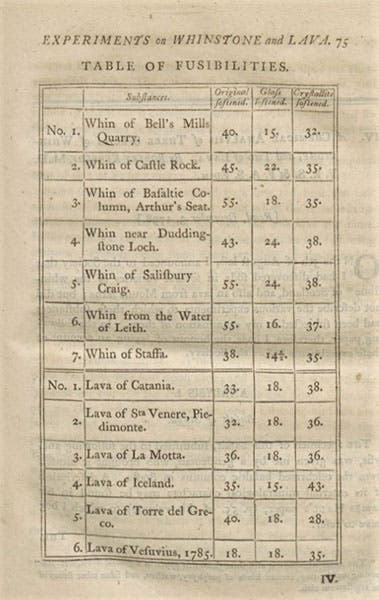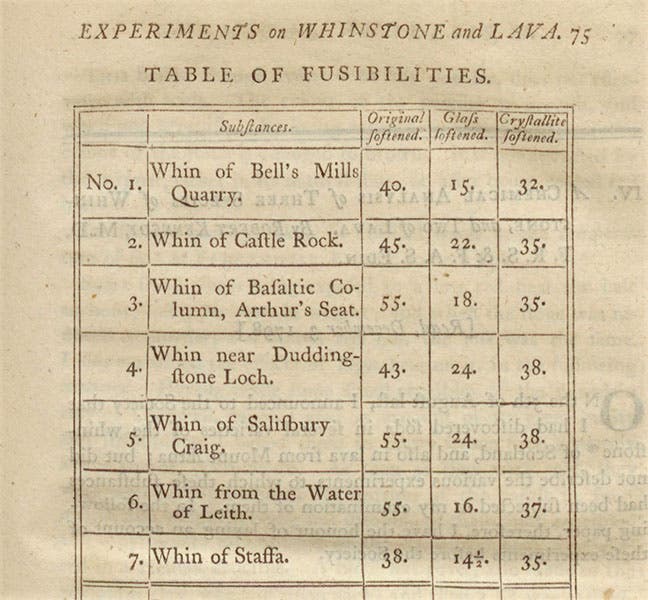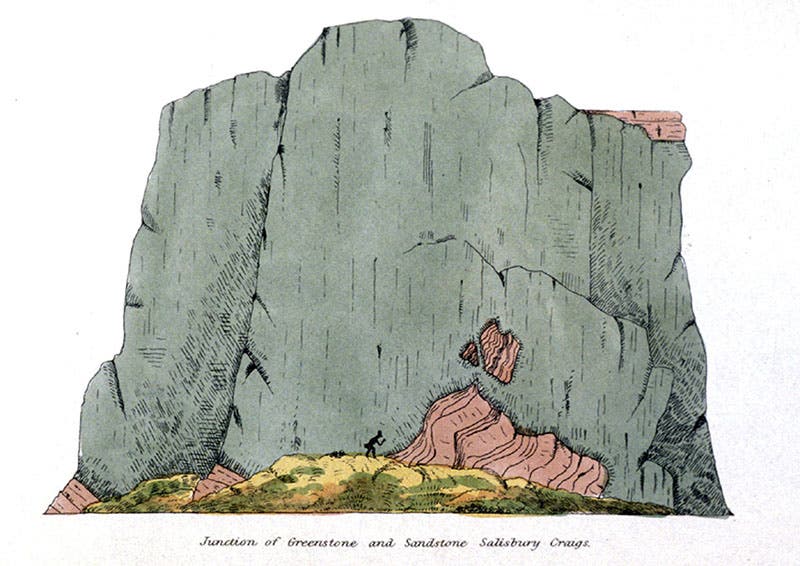Scientist of the Day - James Hall
James Hall, a Scottish chemist, geologist and member of Parliament, was born Jan. 17, 1761. After pursuing an undergraduate degree at Cambridge, he returned to Edinburgh University, where he studied chemistry with the renowned Joseph Black, and geology with John Walker, one of the first lecturers in geology anywhere, and a field geologist to boot. He soon met the Edinburgh geologist James Hutton, who was in the process of formulating his "theory of the Earth," which postulated that the Earth's rocks were being continually recycled, the principal driving force being the Earth's internal heat. He also maintained that certain kinds of rock that had long been considered sedimentary, such as granite and basalt, were actually plutonic in origin, basalt being slowly cooled volcanic rock, while granite cooled even more slowly deep down beneath the Earth's surface. Hall took a keen interest in Hutton's work and travelled with him on occasion about the Scottish countryside. He was even with Hutton in 1788 when Hutton discovered the "unconformity" at Siccar Point on the Scottish coast, a place where two rock formations of widely different ages lie one on top of the other. It was in fact the second unconformity observed by anyone, anywhere, the first having been found by Hutton the year before at Jedburgh.
Hutton was at this time writing the book that would make him famous, Theory of the Earth, published in two volumes in 1795. Hutton's claim that granite. a coarse crystalline rock, had cooled from molten magma, was resisted by nearly every other geologist, so Hall offered to test this hypothesis in the laboratory. Hutton would have none of it. He warned against those who "judge of the great operations of the mineral kingdom from having kindled a fire and looked into the bottom of a little crucible." Hall respected Hutton's wishes and did not bring geology into the laboratory – until Hutton died in 1797. At that point, Hall almost immediately began a series of experiments, in which he melted rock samples in the lab and then cooled the molten specimens over varying intervals of time. His first experiments were with whinstone and lava. Whinstone (alias greenstone) was the Scottish term for what others called traprock or basalt. Hall gathered samples of whinstone from various nearby sites, and lava from more distant volcanoes, including one piece he had himself brought back from Mount Vesuvius. He found that he could turn lava into basalt, and basalt into lava, just by changing the rate of cooling. He also showed that, chemically, whinstone and lava were identical.
His paper was read to the Royal Society of Edinburgh in 1798, but it wasn't published in the Society's Transactions until 1805, as the Society worked to catch up on a backlog of unpublished papers. We show here a detail of the opening page (second image). Hall included a table at the end that summarized his work (third image). He carefully identified where he obtained each sample, and the temperature it took to melt it the first time, and then subsequently. The temperatures indicated are those of the Wedgwood scale, as Wedgwood's pyrometer (high temperature thermometer) was the only device that could deal with the extreme temperatures of molten rock. We discussed and illustrated a Wedgwood pyrometer in our post on Wedgwood.
One of Hall’s samples (the fifth in his table; see detail above) came from the Salisbury Craig, a rock formation that juts up just outside Edinburgh, and since we don’t have a lot of other illustrations for this post, we thought we would show you a near-contemporary etching of the Salisbury Craig. This is where Hutton found pieces of the underlying sedimentary rock literally floating in the whinstone, good evidence that the whinstone was once molten. And that is why there is a tiny geological figure, perhaps intended to be Hutton, wielding his geological hammer at the bottom of the print. Since the image is hand-colored, you can also see why whinstone was often called greenstone.
In subsequent papers, Hall tackled granite, which he believed took its characteristic form because it cooled not only slowly, but under great pressure. He found ways to cool molten rock under pressure in his laboratory and confirmed that the larger crystals of granite could be duplicated under laboratory conditions. Hall published 8 papers in all on the subject, most of them in the Transactions of the Royal Society of Edinburgh, and helped convince many people, such as John Playfair and Charles Lyell, of the validity of Hutton's plutonism.
Interestingly, Hall did not agree with all elements of Hutton's theory of the Earth. Hutton adamantly denied that raging catastrophic floods had played any role in shaping the Earth's surface, as most Neptunists believed. Hall thought Hutton was wrong about this, believing that there was abundant geological evidence of catastrophic flooding, scouring river valleys and transporting rocks. In this matter, Hutton turned out to be right, and Hall wrong.
Being a baronet, Hall had his portrait painted several times, and we show them both here. The portrait of a young Hall (first image) was painted in 1785 by Angelica Kauffmann. It was about this time that Hall met Hutton. The other portrait of a much older Hall, by James Watson Gordon, is undated, but was probably painted around 1825 (sixth image). It is in the portrait collection of the Royal Society of Edinburgh.
Dr. William B. Ashworth, Jr., Consultant for the History of Science, Linda Hall Library and Associate Professor emeritus, Department of History, University of Missouri-Kansas City. Comments or corrections are welcome; please direct to ashworthw@umkc.edu.







![Columbine, hand-colored woodcut, [Gart der Gesundheit], printed by Peter Schoeffer, Mainz, chap. 162, 1485 (Linda Hall Library)](https://assets-us-01.kc-usercontent.com:443/9dd25524-761a-000d-d79f-86a5086d4774/3829b99e-a030-4a36-8bdd-27295454c30c/gart1.jpg?w=210&h=210&auto=format&fit=crop)



